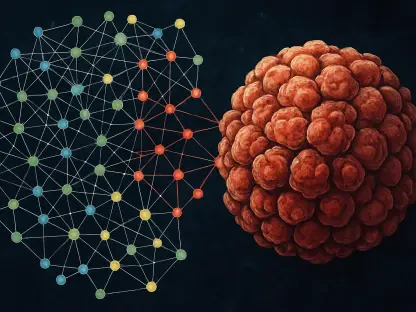Imagine a world where cancer treatments are so precise that they target only malignant cells, leaving healthy tissues untouched, while harnessing the power of artificial intelligence to predict and optimize patient outcomes with incredible accuracy. This is not a distant dream but the imminent reality of the Smart Cancer Nanomedicine Market, which is poised for remarkable growth from 2025 to 2035. A comprehensive analysis by Vantage Market Research underscores how this innovative sector, blending nanotechnology with cutting-edge digital tools, is set to transform cancer care. The urgent global demand for effective therapies, coupled with rapid technological advancements, is driving this market forward, offering hope for improved survival rates and reduced healthcare burdens. As this field evolves, it promises to redefine the standards of medical treatment through personalized and highly targeted approaches.
The momentum behind smart nanomedicine stems from its ability to deliver drugs at the nanoscale directly to cancer cells, minimizing side effects and enhancing efficacy. When integrated with technologies like artificial intelligence (AI) and machine learning (ML), these solutions become even more powerful, enabling healthcare providers to analyze complex data and tailor therapies to individual needs. This convergence is paving the way for a new era of precision medicine, where treatments are as unique as the patients themselves. Moreover, external factors such as the COVID-19 pandemic have accelerated digital adoption in healthcare, pushing the boundaries of how cancer care is delivered and managed.
Market Drivers and Technological Innovations
Revolutionizing Cancer Care with Technology
The backbone of growth in the Smart Cancer Nanomedicine Market lies in the seamless integration of nanotechnology with advanced tools like AI, ML, and digital health platforms. These innovations are redefining cancer treatment by enabling early detection and highly targeted drug delivery systems that focus on diseased cells with pinpoint accuracy. Unlike traditional therapies, which often harm surrounding healthy tissues, smart nanomedicine offers a gentler yet more effective approach. The ability to personalize treatment plans based on a patient’s genetic makeup or specific tumor characteristics is proving to be a game-changer. This technological synergy not only improves clinical outcomes but also reduces the physical and emotional toll on patients, setting a new benchmark for oncology care over the forecast period through 2035.
Beyond the clinical benefits, the adoption of these technologies is being driven by a pressing need to address the global cancer burden, which continues to rise. AI and ML algorithms are particularly transformative, as they can sift through massive datasets to identify patterns and predict how a patient might respond to a given therapy. This predictive power allows for real-time adjustments to treatment protocols, ensuring optimal results. Digital health tools further enhance this by providing continuous monitoring, enabling doctors to track progress and intervene swiftly if needed. The result is a more dynamic and responsive healthcare model that prioritizes patient well-being and efficiency, positioning smart nanomedicine as a cornerstone of modern cancer management.
Data-Driven Decision Making
A significant trend shaping this market is the increasing reliance on data to inform medical decisions. Digital health tools are at the forefront, collecting vast amounts of patient information—from genetic profiles to treatment responses—and turning it into actionable insights. This data-driven approach empowers healthcare providers to move beyond one-size-fits-all solutions, instead crafting therapies tailored to individual needs. The shift toward precision medicine, where every aspect of care is customized, is gaining momentum globally, and smart nanomedicine is a critical enabler of this paradigm. By leveraging data, the industry is not only improving outcomes but also reducing costs associated with ineffective treatments, making cancer care more accessible.
The role of data extends beyond individual patient care to broader market implications. Pharmaceutical companies and research institutions are using these insights to streamline drug development, identifying promising compounds faster and with greater accuracy. This accelerates the journey from lab to clinic, ensuring that innovative treatments reach those in need sooner. Additionally, the integration of data analytics helps in understanding market demands and patient demographics, guiding strategic investments. As the healthcare landscape continues to evolve, the emphasis on data underscores a fundamental truth: informed decisions are the foundation of progress in combating cancer through smart nanomedicine.
Regional Dynamics and Growth Opportunities
Leading Markets: North America and Europe
North America and Europe stand as the frontrunners in the Smart Cancer Nanomedicine Market, bolstered by robust healthcare infrastructure and substantial investments in research and development. These regions benefit from well-established medical systems that facilitate the rapid adoption of cutting-edge technologies, positioning them as hubs for innovation in cancer treatment. Favorable regulatory frameworks also play a pivotal role, providing a clear pathway for the approval and integration of new therapies. Leading companies and academic institutions in these areas are driving advancements, ensuring that patients have access to the latest in smart nanomedicine solutions. This dominance reflects a long-standing commitment to improving healthcare outcomes through technology.
The leadership of North America and Europe is further reinforced by strong public and private funding, which fuels groundbreaking research into nanotechnology and digital health tools. Collaborative efforts between tech giants and healthcare providers are common, fostering an environment where innovation thrives. Additionally, high awareness among patients and practitioners about advanced treatment options drives demand for these therapies. While challenges like high costs remain, the supportive ecosystem in these regions ensures they remain at the forefront of market growth through 2035. Their success serves as a model for other areas looking to enhance their cancer care capabilities with smart solutions.
Emerging Hotspot: Asia Pacific
The Asia Pacific region is rapidly emerging as a key growth area for smart cancer nanomedicine, driven by a combination of rising cancer incidence and increasing healthcare expenditures. As populations grow and urbanize, the burden of cancer is becoming more pronounced, creating an urgent need for effective treatments. Simultaneously, governments and private sectors are investing heavily in modernizing healthcare systems, which includes adopting advanced technologies like nanotechnology and AI-driven diagnostics. This convergence of need and investment positions the region as a hotspot for market expansion over the next decade, with significant potential to reshape cancer care delivery.
Beyond economic factors, growing awareness of innovative therapies among patients and healthcare providers in Asia Pacific is accelerating adoption rates. Countries with large populations are particularly focused on scaling up access to cutting-edge treatments to address public health challenges. While hurdles such as regulatory inconsistencies and infrastructure gaps persist, the trajectory is clear: this region is set to become a major player in the global market. Partnerships with international firms and local research initiatives are further bridging the gap, ensuring that the benefits of smart nanomedicine reach diverse populations. This dynamic growth underscores the transformative power of technology in addressing global health disparities.
Competitive Landscape and Strategic Insights
Key Players Shaping the Industry
The Smart Cancer Nanomedicine Market is characterized by intense competition, with industry giants such as IBM Watson Health, Google Health, AWS Healthcare, Microsoft Healthcare, and Roche leading the charge. These companies are not merely participants but active shapers of the market’s direction through substantial investments in research and development. Their focus on creating innovative solutions—ranging from AI-powered diagnostics to nanoscale drug delivery systems—sets the pace for the entire sector. Strategic partnerships between technology firms and traditional healthcare entities are also common, fostering interdisciplinary advancements that push the boundaries of what’s possible in cancer treatment.
Additionally, these key players are expanding their global footprint through acquisitions and collaborations, ensuring that their cutting-edge solutions reach diverse markets. Their ability to leverage vast resources gives them a competitive edge, allowing for rapid scaling of new technologies. However, this also raises the stakes for smaller firms, which must innovate relentlessly to carve out a niche. The influence of these major corporations highlights the interdisciplinary nature of smart nanomedicine, where expertise from multiple fields converges to tackle one of humanity’s most pressing health challenges. Their leadership will likely define market trends through 2035.
Navigating Challenges and Opportunities
Despite the bright outlook for smart cancer nanomedicine, significant challenges loom on the horizon, including high development costs, stringent regulatory requirements, and ethical concerns surrounding data privacy. Developing new therapies at the nanoscale is resource-intensive, often requiring years of research and substantial funding before reaching the market. Regulatory bodies, while crucial for ensuring safety, can slow down the approval process, creating bottlenecks for innovation. Meanwhile, the use of patient data in AI and digital health tools raises valid concerns about security and consent, necessitating robust safeguards to maintain trust.
Yet, within these challenges lie opportunities for those willing to adapt and strategize effectively. Comprehensive market analyses, such as those provided by Vantage Market Research, offer critical insights through tools like SWOT and Porter’s Five Forces, helping businesses identify competitive pressures and areas for growth. Companies that prioritize agility—whether by investing in scalable technologies or forming strategic alliances—stand to gain a significant advantage. Addressing regulatory and ethical issues head-on with transparent practices can also build credibility. As the market evolves through 2035, the ability to balance innovation with responsibility will be key to long-term success.
Future Pathways for Growth
Building on Past Momentum
Looking back, the journey of the Smart Cancer Nanomedicine Market revealed a landscape reshaped by resilience and innovation, particularly in the face of disruptions like the COVID-19 pandemic. The industry adapted by embracing digital tools and remote care models, ensuring continuity in cancer treatment despite global challenges. Major players demonstrated foresight by investing in technologies that addressed immediate needs while laying the groundwork for long-term advancements. This period of adaptation underscored the importance of flexibility and strategic planning in navigating unforeseen obstacles.
Charting the Road Ahead
As the market moves forward, stakeholders must focus on actionable steps to sustain growth through 2035. Prioritizing research into cost-effective solutions can broaden access to smart nanomedicine, especially in underserved regions. Strengthening international collaborations will also be vital, fostering knowledge exchange and accelerating innovation. Additionally, addressing regulatory and ethical challenges with clear, patient-centric policies can build trust and facilitate smoother market expansion. By focusing on these areas, the industry can ensure that the transformative potential of nanotechnology and digital health tools in cancer care is fully realized, benefiting patients worldwide.









